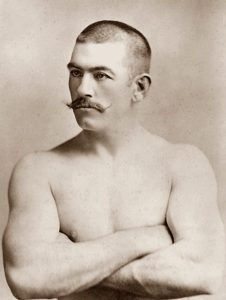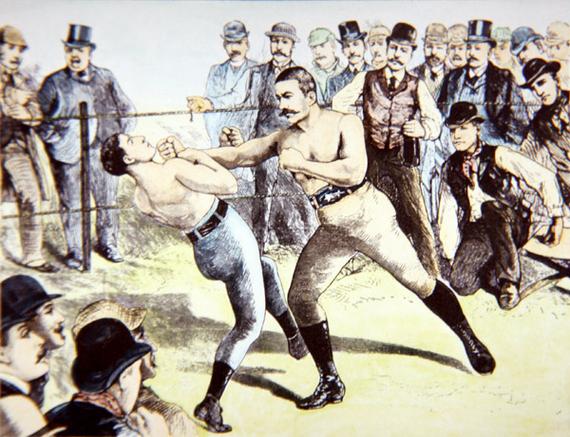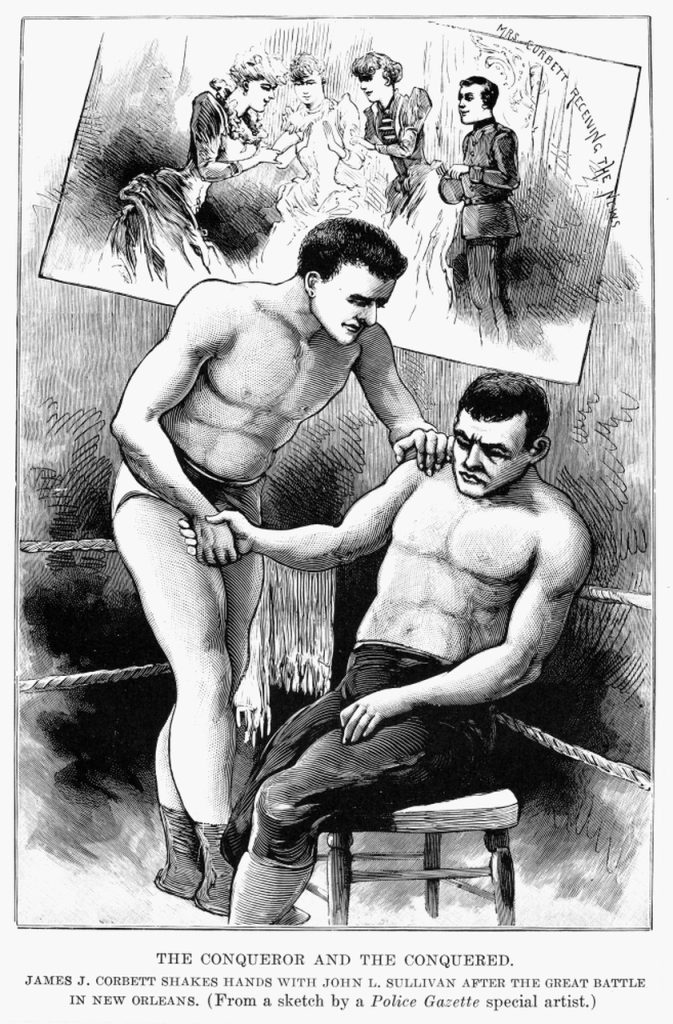
John Lawrence Sullivan, born to Irish immigrants on October 15, 1858, in Roxbury, Massachusetts, grew into an embodiment of the American Dream for many Irish Americans. His parents, survivors of the Great Hunger in Ireland, instilled in him a profound sense of identity and resilience. Though he was an excellent student and his parents aspired for him to attend Boston College and become a priest, destiny had a different plan for Sullivan. Lured by the raw appeal of professional sports, Sullivan found his true calling in boxing, a sport then shadowed by legal ambiguities and often relegated to “exhibitions” or clandestine bouts.
Sullivan’s rise from local fame to national celebrity was meteoric. In one fight, his opponent failed to show, and to quell the restless crowd, Sullivan issued a challenge that became his trademark, “I can lick any man in the house.” This became not just Sullivan’s trademark but a symbol of Irish-American defiance and determination. Through a series of exhibition matches and high-profile bouts, including a legendary encounter with Paddy Ryan in Mississippi, Sullivan’s fists wrote chapters of boxing history. His victory over Ryan, witnessed by figures as diverse as Oscar Wilde and Jessie and Frank James, cemented his status as a champion of the people.
Sullivan’s reign as the Heavyweight Champion brought boxing to the forefront of American sports, making him the nation’s first sports superstar. Leveraging his “I can lick any man in the house” boast, he made a whirlwind of 200 stops across the United States, showcasing his unparalleled strength and skill, endearing him further to an adoring public. Boxing historian Nate Fleisher has observed, “For the first time in their lives, Americans living in the sticks — nearly four hundred thousand American farmers, miners, lumberjacks, artisans, and clerks — laid down their hard-earned cash to see a real boxer in action. They loved it, and the effect of their gratification on the growth and spread of boxing is beyond calculation today.”

Yet, Sullivan was more than a mere athlete; he was a cultural icon, reflecting the grit and determination of the Irish American community still struggling to overcome prejudice and find their place in American society. Such was his fame that to be able to say, “Shake the hand of the man who shook the hand of John L. Sullivan,” brought its own notoriety.
Sullivan never forgot where he came from. In a story that further enhanced his renown in the Irish community, it was said that he refused to stand for the traditional toast to Queen Victoria while attending a dinner in his honor in Victoria, British Columbia. Sullivan stated he “hadn’t been brought up to seeing Irishmen drinking to the health of English monarchs,” he informed the shocked dinner guests.
However, time and age give athletes no special consideration. Add to this that in a phenomenon we see repeated among many modern athletes, Sullivan liked to party, and it became increasingly difficult for him to get in shape. The fight against “Gentleman Jim” Corbett in 1892 highlighted the end of an era and showcased how far boxing had developed under Corbett. No longer were fights held secretly in the dark backroom of a saloon; this fight was held under the glare of the new electric light and the eyes of over 10,000 spectators and reported worldwide. The aging champion and brute strength brawler Sullivan met his match in the younger, more agile, more scientific Corbett. While clearly past his prime and suffering a broken nose in an early round that constrained his breathing, Sullivan would preserve until the last of the 21 scheduled rounds where we was knocked out.

However, even in defeat, Sullivan added to his legacy for the graciousness he accepted, “Gentlemen, all I have to say is that I came into the ring once too often, and if I had to get licked, I’m glad it was by an American.” Sullivan’s grace in defeat, acknowledging Corbett’s victory as a passing of the torch to a fellow American, exemplified his character.
John L. Sullivan’s legacy is not merely confined to his boxing achievements; it is interwoven with the narrative of Irish-American struggle, perseverance, and success. His life story, from the streets of Roxbury to the heights of boxing fame, resonates with the spirit of a community that literally and metaphorically fought to carve out a place in America. Sullivan’s journey embodies the complexities of the American Dream, reminding us that heroes are not defined by their victories alone but by their ability to inspire, persevere, and stand with dignity and pride regardless of the outcome.